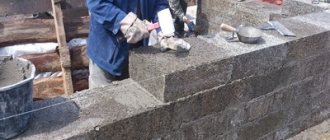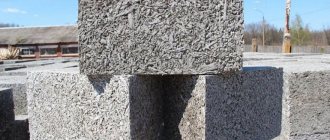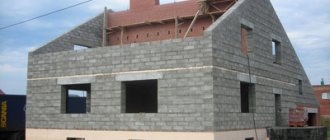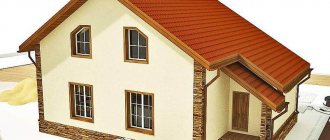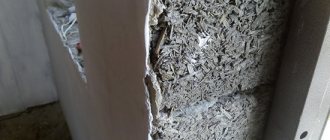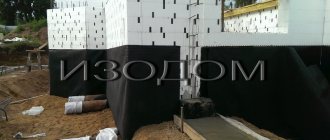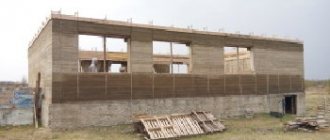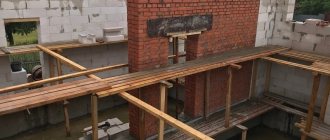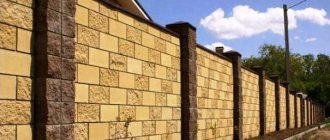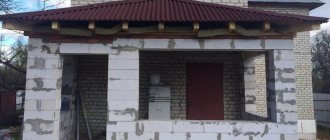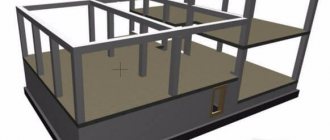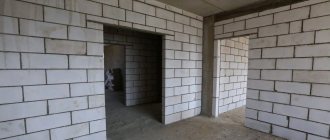One of the main choices that a person makes before starting to build his own home is determining the main building material. Classic options like brick or wood do not always turn out to be optimal after detailed analysis. Sometimes the best choice is a house made of wood concrete, a material that at first glance seems exotic. The reason for this is its technical characteristics, which in some cases are significantly higher than those of brick, wood or concrete. The article will discuss the advantages of an arbolite house and what needs to be taken into account during its construction.
A little history, wood concrete is not some kind of innovation, it was created in the 1960s. in the USSR, and the Dutch development Durisol, which had already become popular by that time in Europe, was taken as a basis. In the Soviet Union, more than 100 factories were involved in the production of this building material. Arbolite was standardized and produced in strict accordance with GOST. In the 90s factories, for well-known reasons, fell into disrepair, and this area of construction experienced a temporary decline.
Construction methods and technology
Let us consider step by step the technology of monolithic house construction from wood concrete.
Foundation and plinth
The choice of foundation type and calculation of its dimensions depends on the composition and properties of the soil, local climatic conditions, soil freezing depth, and groundwater level. One of the advantages of wood concrete is its low weight, which allows you to install a pile-grillage foundation or a strip foundation with a shallow depth for the foundation. The minimum permissible values for the height of the plinth for arbolite monoliths vary between 500-800 mm. When pouring a strip base, it is recommended to make it monolithic, as a continuation of the foundation structure.
Installation of formwork
The use of a permanent formwork system leads to higher construction costs. Therefore, removable disposable panel or inventory formwork is most often used in the form of reusable blanks made of boards, plywood, plastic, and metal. The form-building elements are mounted on the supporting structure of the house in such a way that their lower edges overlap it. The panels are connected to each other using wooden jumpers in increments of 0.5-0.8 m and additionally fastened with metal pins.
Preparation of working solution
The ratio of components in the solution for the construction of external wall structures of a one-story house made of class B1 wood concrete looks like this:
- organic component – 200 kg;
- cement mixture grade M500/M400 – 300-330 kg;
- active fillers – 8 kg;
- water – 350-390 l.
When making homemade wood concrete, instead of expensive ingredients such as aluminum sulfate, more affordable components are used as active additives - lime or liquid glass, mixed in equal proportions.
Walling
Today, there are three known methods for pouring monolithic arbolite wall structures.
- By floors. The monolith is erected with permanent formwork for the floor or foundation using the continuous pouring method. The cement mass is supplied by a local concrete-mortar plant or an automixer.
- By the belts. The entire contour of the building is equipped with formwork up to a meter high with sequential movement of forms for pouring the cement mass from bottom to top.
- By segment. In one pour, a part of the wall structure is formed with a fixed length, height and having limiters on the sides.
If you plan to build a house with your own hands without involving a professional, then it is better to abandon the first two methods of pouring, due to their labor intensity, in favor of the last option. It is quite possible to implement it on your own, and without using a concrete mixer.
Work order:
- The prepared segment is filled with wood concrete mixture. When filling the form with mortar, do not add it 4-5 cm to the upper border of the formwork structure panels.
- The poured mixture is compacted manually using a pin, which is used to sequentially bayonet the formed mass of wood concrete to get rid of air bubbles inside the material.
- When the poured segment of the wall structure has hardened, the formwork is dismantled and installed in the next section, repeating the same steps as during the previous pour.
- The rearrangement of the panels and the filling are first carried out in one plane, forming a closed contour of the building, and then the entire system is raised to the higher tiers.
Floor arrangement
You can do this in several ways:
- install the formwork structure and fill it with wood concrete mortar in two layers;
- make an armored belt around the perimeter of the walls under the reinforced concrete slabs, and pour a leveling screed on top;
- install a prefabricated monolithic floor (SMP) for pouring concrete mixture.
SMP is a frame system formed by reinforced concrete beams in combination with blocks installed between reinforced concrete elements. When the cement mass poured into the lower part of the structure hardens, the SMP becomes a sealed monolith.
Construction of internal walls and ceilings
The construction of interfloor spaces is carried out using the same methods that were used for the floor. Partitions can be erected in a monolithic manner or arbolite tongue-and-groove blocks can be used to create internal walls. At the end, the rafter system and roof are installed, the facade is faced and the blind area is laid.
Installation of floors, ceilings and partitions
The joists and subfloor are installed at the stage of installation of the lower trim around the perimeter of the house and under the internal walls and partitions. The grillage must be laid in compliance with the horizons. The logs are mounted on the strapping beam in increments of 60 cm and secured to it using metal plates and corners with self-tapping screws. In some places long nails are used. Rough boards are attached to the lower edge of the joists. A layer of glassine or other material is laid on the subfloor boards to act as a vapor and waterproofing barrier. For strength and cohesion of the structure, reinforcement is laid around the perimeter. The result is a base for wood concrete filling, which is carried out gradually, as the mixture is ready. The top surface is smoothed to make subsequent layers of the floor structure easier to lay. And wood concrete produces a very high-quality thermal insulation layer.
Partitions and ceilings are constructed according to the same principle as floors. Only for partitions you can use not a monolithic construction method, but make blocks of the required thickness on the ground. And then use them to lay out the internal walls. You can construct formwork for blocks from boards yourself. Lay it on a flat base and form blocks.
Wood concrete: “old new” lightweight concrete
Private construction involves the use of simple technologies and those materials that do not require special equipment for processing, so lightweight concrete often outperforms heavier or capricious “colleagues” in competition. Wood concrete is also often classified as lightweight concrete, but this is not an entirely correct definition, since it does not contain sand.
A Brief History of Wood Concrete
Arbolite, another name for which is wood concrete, was invented in the Netherlands in the first half of the 20th century (in the 1930s). They called it DURISOL. The material appeared in the USSR 30 years later: It was simply copied from the original sample.
In the 90s, wood concrete was forgotten: the factories producing it were either repurposed or collapsed. And at the beginning of the new century, when humanity began to think about the planet and its future on it, the forgotten wood-concrete was remembered again. And for good reason. Now it is considered as a worthy replacement for cellular concrete, blocks that are relatively fragile and therefore not very durable.
Its composition, production
Arbolite - a composite - is a material with a complex composition. It includes:
- Wood chips, usually softwood. In addition to it, stems of hemp, flax or cotton can be added. Organic filler occupies approximately 80-90% percent of the volume. Wood concrete differs from sawdust concrete in a certain size of chips.
- Cement, a traditional binder found in all concrete. Maximum strength is important for wood concrete, so in its production only high-quality cement is used - M400 or M500.
- Mineralizers. Their task is to neutralize sugar in wood, improve the adhesion of organic matter to the solution, and give strength to concrete. Aluminum sulfate, liquid glass, and calcium chloride play this role.
The crushed wood chips are soaked and treated with chemicals. Another, more environmentally friendly way is air drying for 4-6 months. Such a long period allows you to get rid of sugar without the use of additives. Then a mixture of organic matter and cement is prepared and poured into molds. Blocks with mortar are compacted using vibrocompression machines and then dried in air.
Blocks, panels, and slabs are made from wood concrete. Products differ in density and different chip content. Products are divided into structural products, which are used for the construction of walls, and thermal insulation products, which are used to insulate structures inside a building. The density indicator is expressed in numbers (5-50). The blocks are narrow, wide, medium and connecting.
Basic properties of wood concrete
Since the material is 90 percent wood, it takes on its best qualities: low thermal conductivity, good sound insulation and thermal conductivity. In addition, the material belongs to the category:
- environmentally friendly;
- highly resistant to fungi, mold, and aggressive substances;
- having good heat transfer and high heat capacity;
- easy to machine.
Wood concrete is lightweight and has excellent impact resistance. Resists bending well. However, due to porosity, like all lightweight and cellular concrete, it requires particularly careful finishing of the facade.
Monolithic wood concrete is not the most common technology. Private developers prefer to use heavy concrete. The properties of wood concrete make it possible to use it for the construction of buildings as the main forming composition. Such construction allows achieving optimal costs.
What kind of foundation is needed for a house made of wood concrete blocks?
One of the important features of this material is its good bending strength. Thus, arbolite blocks quickly recover after even heavy loads. This option reduces the restrictions on choosing the type of foundation for the house.
When choosing a foundation option, you need to understand the following: wood concrete is light in weight and the foundation may not be as powerful as in other buildings. And you don’t need to go too far down for the walls to be protected from moisture.
Types of foundations for a house made of wood concrete
One of the optimal foundation options is the pile type.
This foundation option is optimal for construction in areas where the soils have low density or complex terrain. The piles used are specially manufactured rods made of reinforced concrete or steel. They are buried to a level determined by the design in order to create sufficient structural strength. The foundation for a wood concrete house requires a careful approach to choosing the type of pile rods. The most commonly used are bored piles and screw models.
The foundation for a house made of wood concrete on bored piles is one of the strongest types of structures. Monolithic reinforced concrete rods are erected directly on site. First, special holes are made in the soil of the appropriate diameter into which the piles are immersed. The technology for arranging a pile foundation is absolutely identical for a wood concrete house and for any other type of structure. The step between the supports is set to 3 meters. This allows you to create sufficient load-bearing capacity.
Many designers and customers choose wood concrete on screw piles. This technology is also strong and durable, but requires minimal effort and time. A house made of wood concrete on screw piles has a long service life. The pile cores are created in a special way, each of them has blades and is easily screwed into any soil. Installation is extremely simple and does not require special equipment.
Construction of a foundation for a house made of wood concrete
Among these options, the bored method is preferred. This technology allows you to reduce costs without compromising structural strength. In addition, when building a foundation for a wood concrete house, it is recommended to use additional fastening for the building. This is done using reinforcing rods of a given length. The grillage is firmly connected to the rods and the result is an excellent and durable structure. The grillage itself is designed to ensure that all the piles are combined into a single system. This way it is possible to evenly distribute the load and create a truly powerful and common foundation.
When building a house from wood concrete blocks, you should carefully study the types of grillage designs. For house construction from wood concrete the following is used:
- Recessed grillage (depth 20 cm into the ground).
- Hanging grillage. This type of construction raises the walls 10 cm from the ground surface.
Before settling on a certain type of grillage, it is necessary to carefully study all the soil parameters obtained from the results of geotechnical surveys.
A strip base is also often considered as a foundation option for a wood concrete house
Before developing a project and proceeding to work on the construction site, it is important to carry out all the necessary preparatory work and surveys. If the soil density indicators are high enough, then during the arrangement you can choose a shallow-depth design option
In other words, the concrete belt need not be lowered below the freezing depth.
Choosing a base for a house made of wood concrete
The buried type of foundation is optimal for low soil density. In such situations, the use of increased depth helps to create sufficient structural strength. The wear resistance and durability of such a project deserves high marks from experts.
When building any of these options, be sure to use heat-insulating material between the ground and the foundation walls.
The foundation for wood concrete is calculated individually each time. The building site has many factors that influence the strength, technical and operational characteristics of the future building. At the design stage, the technical parameters of the structure must also be taken into account.
Characteristics of monolithic wood concrete
The main difference between a monolith and building blocks is the absence of cold bridges. Arbolite has low thermal conductivity, solid walls of structures have increased heat-shielding characteristics.
Benefits of use
The advantage of monolithic wood concrete is its technical and operational characteristics:
- thanks to the treatment of wood chips with fire retardants and mixing it with cement, the resulting building material does not burn;
- high thermal insulation and sound insulation characteristics;
- the material is easy to process;
- resistance to negative temperatures;
- long operational period;
- Mold and mildew do not form on the surface of the material.
If the established proportions for preparing the solution are observed and the structures for pouring are properly arranged, the technical performance of the building material increases significantly.
Disadvantages of monolithic composition
In addition to the advantages, monolithic wood concrete has its disadvantages, for example:
- the material is not resistant to aggressive chemical compounds;
- absorbs moisture well.
The building material intensively absorbs water, causing it to swell. When constructing monolithic structures, an additional protective layer must be applied to the walls. Installation work is carried out only in low ambient humidity. The bases for buildings made of wood concrete are covered with a reliable layer of waterproofing.
This may be interesting: Types of strip foundations
Wood-concrete structures also attract rodents, which can easily make holes in the material.
Areas of application of the monolith
As mentioned above, the composition of foam concrete has properties that allow it to be used in a wide variety of areas of construction.
Walls
Thanks to permanent formwork, the walls become three-layered: a layer of foam concrete and two layers of frame (inside and outside). This allows you to obtain very high thermal insulation without additional insulation.
If a building of several floors is being built, then two brick walls can act as permanent formwork. Later, the gap between them will be filled with foam concrete.
The frame from the inside can be mounted from plasterboard sheets. They are very convenient in interior decoration, therefore they are an indispensable material for permanent formwork. You can also use fiberboard sheets for the inside of the formwork and metal for the outside.
We install formwork for the walls
Wood or plywood can be used as formwork. Such materials most often appear in removable formwork. In order to subsequently be able to use them for other purposes, the formwork should be carefully covered with polyethylene before pouring the liquid mixture.
Whatever option is chosen, the frame must be made in such a way that monolithic foam concrete in permanent formwork does not exert excessive pressure on the walls, as a result of which the structure could bend or bend. To do this, all frame supports should be placed at a distance of no more than 60 cm.
Floors
A difficult task in construction is pouring a leveling screed for floors. However, monolithic pouring of foam concrete can solve this problem. A high-density mixture of grades D800-D1200 is perfect for screeding. Thanks to the porosity of the material, firstly, the load is reduced, and secondly, sound insulation characteristics are improved.
The thickness of the screed should be at least 3 cm, sometimes it is up to 5 cm, and in some cases up to 10 cm. Another effective option is when the lower part of the floors is filled with foam concrete with a density of 300-500 kilograms per cubic meter, and the upper part with a mixture of more high density or even concrete screed. Of course, for each individual case there is a correct solution.
Roof
If we talk about insulating a flat roof, then monolithic filling with foam concrete is an excellent option. Thanks to this method, there are no cold bridges, and the poured layer is both a leveling screed and insulation.
This material is fire-resistant, which is very important for the roof of a building. This makes it stand out among commonly used insulation materials.
It is also not susceptible to rotting, mold or mildew. Therefore, it is used on the roofs of private houses and businesses, as well as on damaged roofs.
Floors
Monolithic foam concrete can significantly reduce the load of floors on the foundation. Also, thanks to this technology, sound insulation increases, which is especially valuable in multi-story buildings.
When pouring foam concrete into a frame for flooring, accelerators, plasticizers, and hydrophobic ingredients are added to the concrete mixture.
Industrial use
Since foam concrete has thermal insulation properties, it is advisable to use it for insulating pipes. Moreover, this can be done both at the facility itself and during manufacturing. There are also no restrictions on the length or diameter of pipes that need to be insulated.
Another option for using foam concrete for industrial purposes is to fill voids created by building tunnels or digging trenches. This material can also serve as a base for road surfaces. Of course, the density of the material in such cases must be high.
Wall insulation
When a building was built a long time ago and needs insulation, you can use the thermal insulation properties of foam concrete for these purposes. In this case, it is necessary to attach a light frame to the walls at a short distance equal to the thickness of the insulation. DSP sheets can be used to cover the formwork frame. Upon completion of work with the formwork, the liquid mixture should be poured into the formed wall.
Manufacturing Features
The porous material meets all thermal insulation standards and helps create a rigid frame. At the same time, it is quite light and does not sink at all in water. This makes working with monolithic blocks comfortable and convenient. Such features make the material popular among builders and home owners.
Foam concrete blocks meet all thermal insulation standards. They include many parameters, including frost resistance and strength.
Foam concrete is produced on any site. But for the accuracy of the process and the creation of high-quality material, it is necessary to comply with certain standards. Therefore, without proper experience, it is advisable to entrust production to professionals and purchase finished products.
The monoliths contain sand and cement. The composition is mixed in certain proportions and can be aerated
At the same time, it is important to maintain temperature conditions on the site. The air should not be cooled below 100
The process of enriching the sand-cement mixture with oxygen must be carefully controlled. It is extremely difficult to do this on your own. In production, special electronics are used for control purposes. This greatly simplifies the process and makes production higher quality. The finished mixture is poured into reinforced molds. If necessary, it is thickened with a finish. To make structures stronger, reinforcement is sometimes used in manufacturing.
Another advantage of a ready-made foam concrete block purchased in a store is the ability to measure density and conduct tests. This helps ensure the strength and durability of a structure made from such material. The ideal density should be 200 kg/m3.
How to prepare the solution
To prepare wood concrete with your own hands, you will need a container with low sides, which is convenient for mixing the composition. Organic contents must be placed in any container and soaked in a weak lime solution or water. It must be kept in the solution until completely wet. Then the wood chips should be thoroughly squeezed out and placed in an even layer in the prepared container. A layer of quicklime is placed on top. Separately, it is necessary to thoroughly mix the dry cement with mineral additives and then mix with water. Working with a mixer, the cement component is added to the mixture of wood chips and lime. Stirring continues for about half an hour. During this time, the lime slaking process should be completed. The exact composition of the workforce is determined empirically, an approximate one looks like this:
- organic contents (shavings, sawdust, wood chips, etc.) – 0.5 cubic meters;
- quicklime – 40 kg;
- Cement M500 – 100 kg;
- additives and water - according to calculation.
To fully guarantee that a solution of the required strength and density is obtained, you first need to make a prototype and conduct tests. Based on the results, the material consumption is adjusted so that the wood concrete monolith is obtained with characteristics suitable for a particular case.
Monolithic construction technology
For monolithic buildings made of wood concrete there is no need to construct a reinforced concrete floor. Lightweight wood concrete is installed on a strip foundation. Its width should correspond to the thickness of the walls.
The technology for constructing monolithic buildings is not particularly complex. Often this type of house is built with your own hands:
- When pouring the foundation, reinforcement bars are placed up to the floor level of the next floor of the building. The more floors it is planned to build, the thicker the details of the reinforcing structure are selected.
- The formwork knocked down to the required size is laid on the foundation so that its lower part overlaps the strip base. The parts of the mold for pouring are connected with metal pins. All side cracks are closed with wooden scraps. After the wood concrete has completely hardened, the formwork is removed, and the fasteners are cut off so that there are no unnecessary holes.
- Arbolite solution is poured into correctly installed formwork. The composition of the mixture is prepared according to the type of wall - internal or external. The form should be filled so that its edges from the top cut remain five centimeters free.
- The poured solution is thoroughly compacted over the entire surface. A metal pin is used for this. This compaction will eliminate air bubbles from the material, increasing its strength.
- The formwork is removed only after part of the wall has completely hardened. After this, it is cleaned, impregnated with an oily substance and set out for filling the next area. The shape is moved in one plane until the perimeter is closed. Next, the climb to the upper sections is carried out.
Monolithic wood concrete, view inside the formwork during backfilling and compaction. When the lower walls are completely filled, the floor of the next floor is installed.
For this purpose, formwork is specially installed, which is filled with an arbolite mixture or laid out to cover reinforced concrete slabs. Then the upper walls are poured in the same way as the first floor. Thermal insulating arbolite mortar is used to fill the openings between double brick walls. This design significantly reduces the heat transfer of brick structures and greatly simplifies the construction of the building.
Tips for construction
- Select wood concrete blocks correctly; when choosing, keep in mind that the construction of different structures requires a block of different thicknesses and densities. For example, for a one-story outbuilding, blocks are taken that are designed for a smaller load than for the construction of a two-story house. Of course, you can make a capital building, take formwork designed for a larger load and require more reinforcement, but in the case of a one-story outbuilding, this will be extra expenses. On the contrary, if you are building a two-story building, you cannot save on reinforcement and blocks by choosing ones that are not strong enough.
- The larger the area of voids in the block, the more funds will be required for its reinforcement
- Carefully study product quality certificates, as unscrupulous manufacturers add plasticizers with phenol and naphthalene to the formwork material, which are harmful to the body and neutralize the inherent environmental friendliness of the material.
Types of monolithic foundation designs
Types of monolithic foundation designs
As already noted, a monolithic foundation is a slab laid in a previously prepared place. But, nevertheless, there are several ways to make such a base. They differ from each other in their hydro- and thermal insulation options. As you already understand, a strip monolithic foundation is a little different. There, the earth is dug up only for the foundation, if there is no basement, and the earth remains under the space of the rooms. Here the entire volume of earth is excavated, under the entire area of the house.
The simplest of these types of foundations is performed according to the following scheme:
A reinforcement structure is installed at the bottom of the pit, on a pre-compacted sand cushion, and then filled with concrete. More complex ones include structures that use sheets of waterproofing material, geotextiles, and, depending on the type of soil, it is possible to make an additional cushion from crushed stone.
The most complex monolithic foundation looks like a multi-layer sandwich in cross-section:
- sand cushion;
- layer of geotextile;
- layer of crushed stone;
- the so-called preparatory layer of concrete;
- waterproofing layer;
- monolithic slab.
Such complex structures are used on difficult soils, for example, with a high groundwater level. Builders with extensive experience say that a monolithic foundation can be used even in peat bogs.
Installation of thermal insulation panels with wood concrete
Although the material can be used for removable structures, the most common are projects made from permanent blocks. One of the most common options is the installation of an arbolite insulating panel. It is performed in 3 stages.
First, the outer side of the wall is made of brick. At the second stage, an internal wall is created from a wood concrete panel. Finally, concrete is poured into the space between the walls. The advantage of this design will be the high thermal insulation properties of the wall due to the combination of the properties of 3 types of material.
This option also has its disadvantages. Firstly, the high moisture permeability of wood concrete plays a role. If the humidity inside the room is high, the liquid will penetrate through the formwork to the concrete layer, which will be destroyed by water. Knowing this feature, it is worth taking measures to reduce the risk of increased humidity inside the house. One of the good solutions would be properly organized ventilation of the room. The second option is to make an additional waterproofing layer for wood concrete.
Secondly, some concrete manufacturers add components to their compositions that negatively affect human health, and a layer of wood concrete formwork will not become a serious obstacle for them to penetrate into the premises.
The solution to this problem will be a more scrupulous choice of concrete mortar for pouring inside the wall. Choosing an environmentally friendly composition will guarantee health for the whole family.
View of wood concrete blocks before pouring mortar
A house made of wood concrete: what kind of foundation is being built under the building?
When choosing a foundation for a house made of wood concrete blocks, you should take into account the composition of the natural soil on the site where the construction of a residential building is planned, the number of storeys of the building, and the size of the building area. Particular attention should be paid to the depth of soil freezing, the presence of a high groundwater level, as well as the composition of the soil under the future house
Tape
Shallow strip foundation
It is customary to build a shallow strip foundation for a house made of wood concrete block on dense soils with a low groundwater level and a shallow freezing depth of the soil.
The technology for constructing a strip foundation (foundation) for a residential building does not differ from the classical technology for constructing strip foundation supports.
To begin with, the construction site should be cleared of bushes, grass and debris. Then the surface of the site should be planned.
The future foundation is marked on the site using driven pegs and a stretched cord. According to the markings, they dig a trench, the depth of which should be at least 0.5 m. The bottom of the trench is leveled, cleaned and compacted.
Then they begin to construct the formwork for the foundation - it is very convenient to use wooden boards or thick plywood. The height of the formwork above ground level is 0.5 m.
The bottom of the formwork is covered with a layer of coarse sand and carefully compacted (the thickness of the backfill of coarse sand in the compacted state is 0.15 m). The waterproofing layer is laid on top of the sand cushion, for which roll roofing felt is used.
A spatial frame made of reinforcing rod with a diameter of 10 mm is placed at the bottom of the formwork
It is very important that the foundation frame does not touch the bottom of the trench, for which it is raised on bricks
Tamping tool - vibrating rammer
The top of the poured foundation structure is leveled by tamping the concrete mixture with vibrating rammers. The surface of the foundation should be as smooth and even as possible.
The foundation for a house made of wood concrete is left to gain strength for 28 days, providing care for the concrete surface - periodic moistening.
To prevent the concrete surface of the foundation from drying out, it is covered from the sun and wind with plastic film. Wetting the base surface continues for several days.
Budget filling option
Instead of a concrete mixture, the formwork of the foundation structure can be filled with an arbolite mixture, which is prepared from sawdust with shavings kept in air for 3-4 months, mixed with cement and lime mortar. Proportion of wood concrete mortar: for 1 part of cement take 1 part of lime, 9 parts of wood waste, from 2 to 4% of other additives. You can mix the composition in a regular concrete mixer.
Filling with wood concrete
The formwork is filled with the solution in the same way as a concrete mixture. The sides of the strip foundation made of wood concrete are insulated with brickwork; along the upper plane of the foundation there is a belt of 5 rows of bricks across the entire width of the strip base. A brick belt for walls made of wood concrete blocks is made regardless of the material from which the foundation for the construction of a residential building is poured.
Pouring a foundation with an arbolite mixture, even with the most careful insulation, is not capable of ensuring the strength of the foundation for a long time.
The finished foundation for a house made of wood concrete must be insulated along the surface of the vertical walls along the entire height of the base. The best results are obtained by insulating the foundation with ordinary polystyrene foam or extruded polystyrene foam with a layer thickness of 100 mm.
Final chords, protection of arbolite walls
With a team of three to four people, a medium-sized box of a monolithic house made of wood concrete can be built in a couple of summer months. But as we said at the beginning, wood concrete does not do well in a humid environment, so it is advisable to protect it immediately.
On the outside of the house we will cover the walls with a waterproofing barrier and line them with siding. From the inside it will be ordinary cement or cement-lime plaster.
The walls of wood concrete houses built half a century ago still look like new today!
Leave your tips and comments below. Subscribe to our newsletter. Good luck to you and good luck to your family!
Pouring concrete into formwork - the whole process from “A” to “Z”
Pouring concrete into formwork
How to pour concrete into formwork? If there are large volumes (when the solution is delivered from the factory on a mixer), concrete is poured immediately along the entire perimeter to a predetermined height. At home, it is usually not possible to prepare a large amount of solution. There are two methods for correctly pouring concrete into formwork using hand-prepared portions of mortar:
- pouring the entire perimeter of the formwork with concrete to a thickness of up to 0.5 meters, while the presence of too thin layers is not allowed;
- Filling a separate area with mortar to the entire height of the formwork. The side edge of the poured concrete should be beveled for more reliable adhesion between the individual parts of the structure.
How to pour concrete into formwork? Concrete supply is carried out:
- manually, carrying buckets of solution;
- direct pouring from a concrete mixer;
- imported concrete is poured directly from the mixer tray; if necessary, the tray can be extended with wooden or metal gutters.
The concrete surface is leveled with a shovel or building rule. If for any reason the work on filling the formwork with mortar is stopped for more than 24 hours, it can be resumed only after the concrete has completely dried. Before starting new concreting, the concrete working seam is wiped with a brush and washed with water.
Features of application in construction
Due to high moisture absorption, monolithic wood concrete requires specific measures for waterproofing walls:
- the distance from the planning ground mark to the bottom mark of the wall must be at least 50 cm;
- on the top of the foundation or plinth it is necessary to lay a layer of waterproofing material or a cement-sand screed with waterproofing with liquid glass;
- protect façade surfaces with plaster, cladding or curtain façade;
- cornice overhang - at least 50 cm.
Structural wood concrete is used for the construction of monolithic external walls with removable or permanent formwork made of plywood, moisture-resistant chipboard or OSB, and boards. Permanent formwork serves as a finishing layer. When using removable or sliding formwork to level the layer and reduce the consumption of cement for subsequent finishing, it is better to wrap the boards with PVC or polyethylene film.
Installation of permanent formwork. We immediately get the façade finished.
Structural wood-reinforced concrete during the construction of 2-story cottages will require additional reinforcement or a load-bearing frame, as well as the installation of reinforced belts under the floor and coating slabs.
Thermal insulation material is used for the insulating layer in masonry or three-layer walls. It can also be used in the construction of frame houses to fill cavities.
Attention! When installing reliable waterproofing, a screed made of monolithic wood concrete can be used to insulate the floor of the first floor on the ground, over the ceiling, including the attic.
Frame elements in contact with the wood concrete mixture must be protected: metal from corrosion, wood from rotting. The frame racks are installed in increments of 1.2-1.5 m, at the openings of windows and doors. To reduce the load on the walls and foundation, it is recommended to carry out ceilings using wooden beams.
The façade and interior surfaces of wood-concrete walls require protection from moisture. This can be plastering, facade cladding with curtain panels, tiles or bricks, plasterboard cladding, plaster or interior wall cladding.
Reviews
Reviews from home owners are almost identical and positive, with the exception of a few dissatisfied ones.
Arthur, Smolensk: My review is positive, because I raised the dacha from monolithic wood concrete, myself and my family. The only difficulties were during the construction of the formwork; it took a lot of time. But there are no problems with wood concrete. We quickly made the mixture in a concrete mixer and quickly poured it in place. The house turned out to be warm, durable, no complaints. We've been living here for 5 years.
Vladimir, Omsk: I read about two years ago on the Internet that duplexes, dachas, multi-storey cottages are being built from wood concrete, saving a lot on this construction. I didn’t take any risks and decided to build a garage out of this material. What can I say - the garage has been standing for a year and a half, there are no problems. I plastered it on both sides and painted it. Looks great.
Preparation of wood concrete mixture
The quality of wood concrete mortar for monolithic construction depends on compliance with the proportions of the mixture and its correct manufacture.
Preparing the Components
The composition of the arbolite filling solution includes more than 80 percent coniferous wood chips. It has a certain size and shape. The standard size of raw materials is 25*5*10 millimeters. If wood particles have a larger volume, then the strength of the material decreases. With smaller sizes, a larger amount of cement mixture is required and at the same time the level of thermal insulation properties decreases.
The composition of the solution for pouring wood concrete includes more than 80 percent of coniferous wood chips
Portland cement is used for the cement base. The brands M500 or M400 are mainly used. To speed up the hardening of the mixture, mineral additives are added, such as aluminum sulfate, calcium chloride or liquid glass. Slaked lime has also proven itself well.
For pouring monolithic structures, wood concrete mortar is prepared depending on its type. For structural wood concrete per 1 cubic meter, the following proportions of the main components are required:
- for density B1 - 210 kilograms of cement and 210 kilograms of crushed wood are used per 360 liters of water;
- B2 – 350 kilograms of cement, 230 kilograms of wood chips and 400 liters of water are combined;
- class B2.5 requires 250 kilograms of softwood filler, 440 liters of liquid and 380 kilograms of Portland cement.
To mix wood concrete, which is used for thermal insulation purposes, 1 cubic meter, depending on density, requires from 280 to 300 kilograms of cement, 300-430 liters of water and from 170 to 190 kilograms of wood chips.
All calculations are used subject to the addition of M400 cement
If dry solution M 500 is used, then the coefficient of 0.96 is taken into account for the proportion
Solution manufacturing technology
The kneading process consists of the following stages:
- Wood chips and a mineral or chemical additive are mixed in dry form. After this, Portland cement is added. All components are stirred until smooth.
- Water is poured into the prepared mixture in a small stream. In this case, you should continuously mix the solution with a construction mixer or concrete mixer. In the finished wood concrete material for pouring, all chips must be covered with a cement mixture. The process of mixing the components takes at least 5 minutes.
A properly made solution should be moist, but not very wet. When adding lime as an additive to completely extinguish it, the solution is mixed for 20 minutes.
Brief information about the material
Arbolite belongs to the group of lightweight concrete. The blocks contain up to 90% organic fillers, as well as cement and chemical additives that do not allow organic matter to influence the hardening process of the binder. The environmentally friendly material has high levels of heat and sound insulation with a low weight of the erected structure.
The unique characteristics of wood concrete make it possible to significantly reduce the thickness of walls and allow its use in regions with harsh climates. Despite the fact that the production of blocks in the USSR was established in the 60s of the last century, the material did not become widespread, and in the 90s the factories were completely repurposed or simply destroyed. At that time, developers paid little attention to energy-saving technologies, focusing on other areas that seemed more promising.
Modern conditions associated with the search for more economical methods of construction have forced us to remember arbolite concrete. The industry is currently undergoing a revival, and for good reason. Objects erected from wood concrete more than half a century ago are in excellent condition, which means the material has stood the test of time. In Europe and America, analogues were and continue to be used, since ordinary residents of capitalist countries value such concepts as “efficiency” and “energy saving”, “environmental friendliness” and “quality”.
Advantages and disadvantages of wood concrete
Interest in wood concrete has revived with the growth of construction of private country houses.
The customer today wants to get a high-tech, durable, warm and, most importantly, not too expensive home. Professional builders, responding to this request, began to more often recommend building a house from wood concrete. According to the currently valid GOST 19222-84, this is the name for concrete based on a cement binder with organic filler and chemical additives. Another capacious name that describes its essence is wood concrete, since wood chips are used in the manufacture of wood concrete, which makes up up to 90% of the volume of the building material. The chemical additives that are present in it are liquid glass and non-toxic resins and salts, so the material is considered highly environmentally friendly.
Modifying components also improve bactericidal properties, regulate porosity and block the negative impact of organic matter on cement hardening. In modern construction, wood concrete is found in the form of ready-made blocks and wall panels, or it is manufactured directly on the construction site as a monolithic structure. Fixed formwork made from this artificial stone is also common.
Advantages of wood concrete
Perhaps the main advantage of this building material is its low thermal conductivity. In this indicator, wood concrete is not inferior to wood, and even surpasses it.
Thermal conductivity indicators of wood concrete and other building materials:
| Material | Thermal conductivity, 10 -3 W/(m K) |
| Pine (across the grain) | 150 |
| Pine (along the grain) | 400 |
| Larch | 130 |
| Oak (across the grain) | 200 |
| Oak (along the grain) | 400 |
| Ceramic brickwork | 810 |
| Ceramic hollow brick masonry | 580 |
| Masonry made of sand-lime hollow bricks | 810 |
| Cinder concrete | 700 |
| Glass | 1150 |
| Wood concrete (density 400 kg/m3) | 80 |
| Wood concrete (density 500 kg/m3) | 95 |
| Wood concrete (density 600 kg/m3) | 120 |
| Wood concrete (density 700 kg/m3) | 140 |
| Wood concrete (density 800 kg/m3) | 160 |
As you can see from the table, the thermal conductivity of wood concrete directly depends on its density.
In accordance with GOST, the material is divided into thermal insulation and structural varieties. The second is used to create load-bearing and enclosing structures of a house and has a density of 500 kg/m3. Higher grades of cement are used in its production. The next indisputable advantage of the material is its lightness. Wood concrete is more than 2 times lighter than brick. This reduces the load on the foundation of the building, making it less massive and saving on material. This same fact makes the work of builders more comfortable and significantly reduces the construction time of houses made of wood concrete. It is very easy to plaster walls, due to the fact that wood concrete has high adhesion, i.e. it provides good adhesion of the surface to the finish. In addition, it is very easy to make fasteners in them, holes can be drilled well, and, due to its strength, wood concrete can easily hold furniture and additional household equipment. Monolithic wood concrete, wall panels and blocks are not sharpened by rodents, they are not susceptible to mold and do not rot. And antiseptic properties significantly increase the service life of the house. Arbolite belongs to low-flammable and low-flammability materials (B1 and G1 clauses 5.4 - 5.5 SNiP 21-01-97), which in itself is a good result. During a fire, it does not spread the flame, but only smolders, increasing the chances of quickly and successfully extinguishing the fire. Proper finishing can increase the fire resistance of a wood concrete wall.
